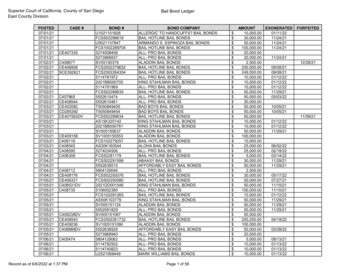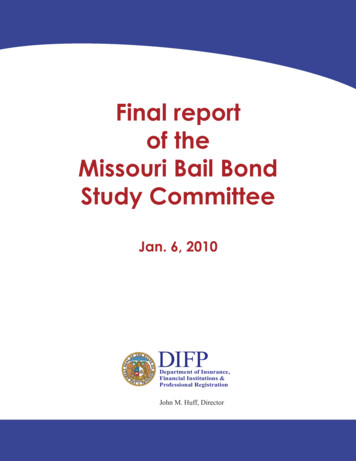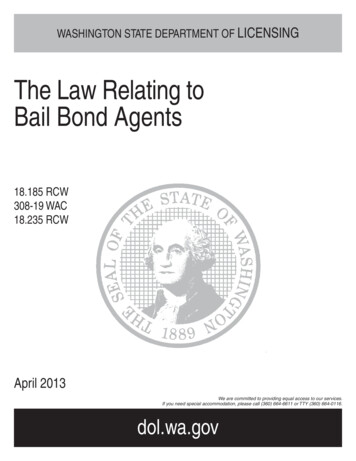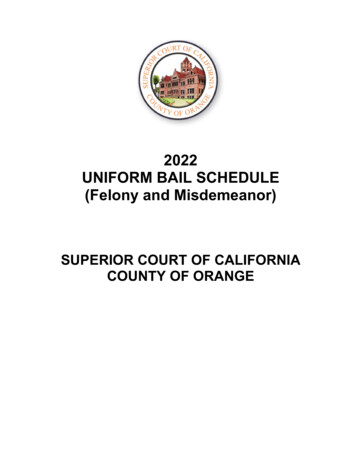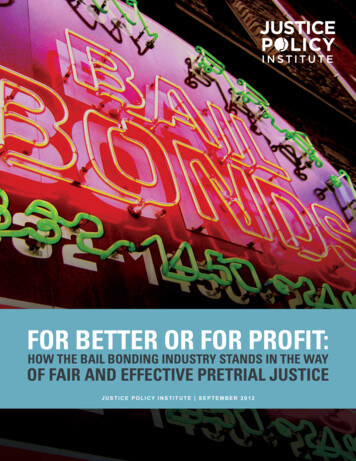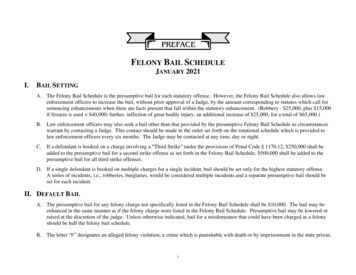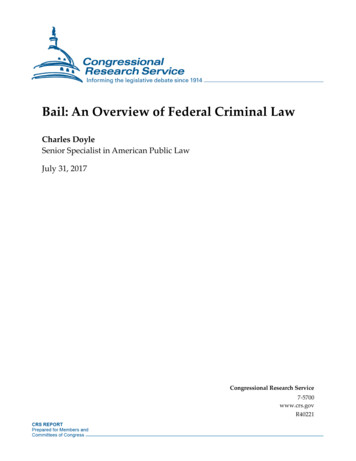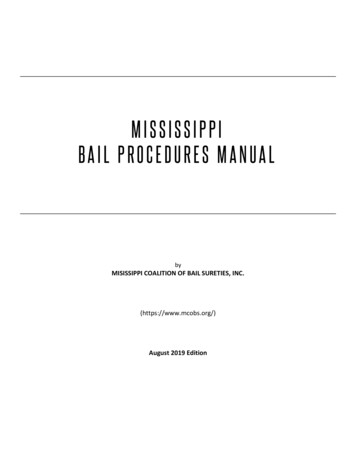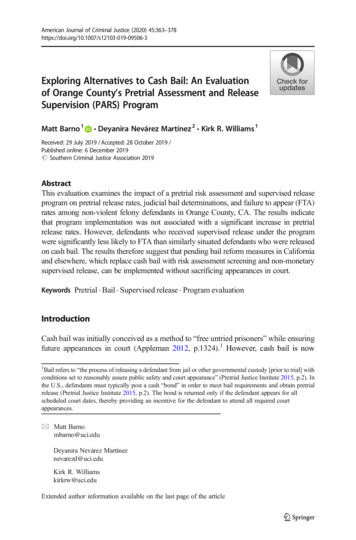
Transcription
American Journal of Criminal Justice (2020) 06-3Exploring Alternatives to Cash Bail: An Evaluationof Orange County’s Pretrial Assessment and ReleaseSupervision (PARS) ProgramMatt Barno 1& DeyaniraNevárez Martínez 2 & Kirk R. Williams 1Received: 29 July 2019 / Accepted: 28 October 2019 /Published online: 6 December 2019# Southern Criminal Justice Association 2019AbstractThis evaluation examines the impact of a pretrial risk assessment and supervised releaseprogram on pretrial release rates, judicial bail determinations, and failure to appear (FTA)rates among non-violent felony defendants in Orange County, CA. The results indicatethat program implementation was not associated with a significant increase in pretrialrelease rates. However, defendants who received supervised release under the programwere significantly less likely to FTA than similarly situated defendants who were releasedon cash bail. The results therefore suggest that pending bail reform measures in Californiaand elsewhere, which replace cash bail with risk assessment screening and non-monetarysupervised release, can be implemented without sacrificing appearances in court.Keywords Pretrial . Bail . Supervised release . Program evaluationIntroductionCash bail was initially conceived as a method to “free untried prisoners” while ensuringfuture appearances in court (Appleman 2012, p.1324).1 However, cash bail is nowBail refers to “the process of releasing a defendant from jail or other governmental custody [prior to trial] withconditions set to reasonably assure public safety and court appearance” (Pretrial Justice Institute 2015, p.2). Inthe U.S., defendants must typically post a cash “bond” in order to meet bail requirements and obtain pretrialrelease (Pretrial Justice Institute 2015, p.2). The bond is returned only if the defendant appears for allscheduled court dates, thereby providing an incentive for the defendant to attend all required courtappearances.1* Matt Barnombarno@uci.eduDeyanira Nevárez Martíneznevarezd@uci.eduKirk R. Williamskirkrw@uci.eduExtended author information available on the last page of the article
364American Journal of Criminal Justice (2020) 45:363–378being questioned nationwide for disproportionately burdening low-income defendants,regardless of their risk to public safety, sparking national discussions about whether thissystem favors the wealthy and criminalizes the poor. Over 65% of detainees in U.S.jails are defendants awaiting trial (Zeng 2018). Nearly all of these pretrial detaineesremain in jail solely due to a financial inability to post cash bond (Rabuy and Kopf2016; Reaves 2013). African-American and Latinx defendants in particular experiencehigher rates of pretrial detention (Ayres and Waldfogel 1993; DeMuth 2003;Schlesinger 2005). Defendants who are incarcerated pretrial are significantly morelikely to be convicted (Dobbie, Golden, and Yang 2018) and to receive longersentences upon conviction (Saks and Ackerman 2014). Despite these issues, cash bailremains the primary mechanism for obtaining pretrial release nationwide, and researchexploring non-monetary alternatives to cash bail is remarkably scant (Bechtel,Holsinger, Lowenkamp, and Warren 2017; Mamalian 2011). Accordingly, the currentstudy addresses the potential effectiveness of an alternative program implemented inOrange County, CA, involving the use of a risk assessment procedure to inform judicialdecisions about non-monetary pretrial release.The issues that plague pretrial detention at the national level are particularly pronounced in California. Pretrial detainees comprise 64% of California’s jail inmates andnearly one-quarter of the state’s total incarcerated population (Tafoya, Bird, Nguyen, andGrattet 2017). California detains 59% of defendants awaiting trial, compared to just 32%in the rest of the country (Tafoya 2015). The median bail amount in California is 50,000,more than five times the median bail amount in the remaining states (Tafoya 2015).Despite high bail requirements, California defendants generally exhibit higher rates offailure to appear in court after pretrial release (Tafoya 2015). A recent California appellatecourt decision, In re Humphrey (2018), concluded that bail reform legislation wasdesperately needed “to correct a deformity in [California’s] criminal justice system.”The state legislature responded by passing Senate Bill 10 (S.B. 10) in August 2018.This legislation would make California the first state in the country to entirely eliminatecash bail, replacing it with a system centered on risk assessment, preventative detention, and non-monetary conditions of release (Romo 2018). Under S.B. 10, mostmisdemeanor arrestees would be automatically cited and released within 12 hours ofbooking in county jail.2 For felony arrestees, the bill would require counties to use avalidated risk assessment tool to evaluate the likelihood that a defendant will fail toappear in court while on pretrial release. Depending on the defendant’s assessed risklevel, the bill would authorize pretrial services agencies and courts to impose a varietyof non-monetary supervisory conditions on pretrial release. The bill would also allowcourts to preventatively detain defendants prior to trial, if the court determined that “nocondition or combination of conditions of pretrial supervision will reasonably assurepublic safety or the appearance of the defendant in court” (Cal. Stat. 2018). GovernorBrown signed S.B. 10 into law on August 28, 2018, and the bill was due to becomeeffective in October 2019 (Romo 2018). However, the California bail bonds industryresponded by gathering enough signatures to initiate a public referendum on S.B. 10,and the bill’s implementation has now been placed on hold pending the result of a 2020ballot initiative (Ulloa 2018).2S.B. 10 excludes misdemeanor arrestees from automatic pretrial release if they are suspected of certainspecified crimes, such as domestic violence offenses (Cal. Stat. 2018).
American Journal of Criminal Justice (2020) 45:363–378365California’s S.B. 10 is illustrative of the type of bail reforms being introduced acrossthe country to expand non-monetary opportunities for pretrial release. The VeraInstitute of Justice described 2017 as a “breakthrough year for bail reform,” as NewJersey, Arizona, and Kentucky each implemented reforms that integrate statistics-basedrisk assessment instruments into decision-making processes about non-monetary conditions of release (Rahman 2018).3 More recently, in April 2019, New York passedlegislation eliminating cash bail for most non-violent arrestees and explicitly encouraging judges to utilize the “least restrictive non-monetary alternative conditions”necessary to ensure a defendant’s future appearances in court (Kamins 2019). However,despite the building political momentum behind these reforms, there is little empiricalresearch that examines either the impact of risk assessment instruments on judicialdecisions about pretrial release or the efficacy of non-monetary release conditions inreducing subsequent failures to appear in court (Mamalian 2011). In a recent metaanalysis of pretrial research, Bechtel et al. (2017, p.443) concluded that “the quality ofpretrial research, overall, is weak at best.” While there is some evidence to suggest thatnon-monetary conditions of release may reduce subsequent failures to appear in court,the authors ultimately argue that “more peer-reviewed, quantitative research needs to becompleted regarding interventions for pretrial services” (Bechtel et al. 2017, p.461).Pursuant to this call for research, the current study presents findings from an evaluationof a pretrial assessment and release program implemented in Orange County (O.C.), thethird most populous county in California and the sixth most populous county in the U.S.(U.S. Census Bureau 2018). Using funds from the California Courts’ Recidivism Reduction Fund, the O.C. Superior Court launched its Pretrial Assessment and Release Supervision (PARS) program in February 2016, two years prior to the passage of S.B. 10. ThePARS program serves as model for both the type of program that all California countieswill be required to implement under S.B. 10 and the type of programs currently beingimplemented across the country to reform and replace cash bail. The PARS programinvolves the use of a risk assessment tool, the Virginia Pretrial Risk Assessment Instrument (VPRAI), to assess the risk that felony arrestees will fail to appear for court ifreleased pretrial. The court and probation department then use these VPRAI risk scores toinform decisions about pretrial release and non-monetary supervisory conditions.This article focuses on the impact of the PARS program on pretrial release decisionsand failure to appear (FTA) rates among O.C. pretrial defendants. The results ultimatelyprovide some empirical support to bail reform efforts in California and across thenation, as participation in the PARS program was associated with a significant reduction in failure to appear rates relative to release on cash bond. The article is organizedinto six sections. Section I begins by reviewing prior empirical research on pretrial riskassessment instruments and non-monetary alternatives to cash bail. Sections II and IIIprovide a description of the PARS program and the research questions addressed in thestudy. Section IV describes the data and methods used to address these researchquestions. Section V reports the results of the study, including the PARS program’simpacts on pretrial release rates, judicial bail determinations, and the likelihood of FTA.Section VI concludes by discussing the study’s implications for current bail reformefforts in California and beyond.3Statistics-based risk assessment instruments are instruments whose predictive validity has been establishedthrough statistical analysis techniques.
366American Journal of Criminal Justice (2020) 45:363–378Literature ReviewFactors Predicting Failures to Appear in Court (FTA)Most of the prior empirical research on pretrial assessment and release programsfocuses on validating the risk factors used to predict whether a defendant will failto appear in court (FTA) if released. An early review of such studies fromEskridge (1981) uncovered mixed results for most of the factors then in use topredict FTA, including community ties, prior criminal record, and possession of atelephone. Employment was the only risk factor consistently associated withappearance in court across the studies covered by Eskridge (1981). However, arecent meta-analysis from Bechtel, Lowenkamp, and Holsinger (2011) illustratesthat subsequent pretrial research has generally produced more positive resultsregarding risk factors that predict FTA. This research suggests that the most robustpredictors of FTA include prior FTAs, prior misdemeanor convictions, otherpending charges, employment status, history of substance abuse, and residentialinstability (see, e.g., Lowenkamp, Lemke, and Latessa 2008; Lowenkamp andWhetzel 2009; VanNostrand and Keebler 2009).Impact of Pretrial Risk Assessment on Judicial Release DecisionsIn contrast to the extensive research on risk factors predicting FTA, researchexploring the impact of pretrial risk assessment instruments on judicial decisionsabout pretrial release is relatively scarce. When properly implemented, pretrial riskassessments have the potential to reduce the number of defendants detained priorto trial dramatically (Cooprider 2009; NIJ 2001). However, as numerous scholarshave noted, judicial buy-in is essential to the successful implementation of riskassessments in criminal justice settings (Goldkamp and Gottfredson 1988;Goldkamp and Vilcica 2009). Most pretrial release decisions are made by a judgeat the conclusion of a bail hearing, and therefore judges ultimately determinewhether and to what extent risk assessment instruments will factor into pretrialrelease decisions. When determining bail conditions, judges may ultimatelychoose to ignore risk assessments entirely, thereby negating any potential benefitsderived from risk assessment screening.Despite the important role that judicial discretion plays in determining how riskassessment scores are incorporated into pretrial release decisions, researchdocumenting judicial responses to pretrial risk assessment is exceedingly rare.As Cadigan and Lowenkamp (2011, p.31) describe, “A seemingly ‘obvious’ issuenot found in virtually any other research on the topic of risk assessment is theimportance of including judicial officers in the development, implementation, andongoing use of a risk assessment device.” This gap in research is especiallynoteworthy in light of the longstanding resistance among criminal justice practitioners to actuarial risk assessment tools that encroach upon discretionarydecision-making processes (Harris 2006). Hence, one of the primary questionsleft open by previous risk assessment research is whether the implementation ofrisk assessment screening is likely to have any significant impact on judicialdecisions regarding pretrial release.
American Journal of Criminal Justice (2020) 45:363–378367Non-Monetary Pretrial Release ConditionsLikewise, research on the effectiveness of non-monetary release conditions in reducingFTA rates is also relatively scarce (Mamalian 2011; VanNostrand, Rose, and Weibrecht2011). In a recent meta-analysis, Bechtel et al. (2017) were only able to identify twopeer-reviewed studies examining the impact of pretrial supervision on the likelihood ofFTA (Goldkamp and White 2006; Robinson, VanBenschoten, Alexander, andLowenkamp 2011). Moreover, both studies compared failure rates among superviseddefendants to failure rates among defendants released without any conditions at all,including the posting of cash bond. Thus, while both studies found that superviseddefendants were significantly less likely to FTA than unsupervised defendants, neitherstudy explored whether supervised defendants were more or less likely to FTA thandefendants released on cash bail.One of the primary factors contributing to the dearth of quality empirical research onnon-monetary release conditions is the difficulty of finding a suitable comparison groupwith which to evaluate FTA rates among supervised defendants. Judicial decisions aboutpretrial release conditions are explicitly based on a given defendant’s FTA risk. Therefore, defendants who are placed on pretrial supervision will likely differ systematicallyfrom defendants who are released under other conditions. These group-level differencesare likely to exert an independent influence on FTA rates, making it difficult to attributedifferences in FTA rates to differences in pretrial release conditions as opposed todifferences in ex ante FTA risk. For example, several studies have attempted to useState Court Processing Statistics (SCPS) data to compare FTA rates among those whopost cash bond and those placed under non-monetary conditions of release (see, e.g.,Bechtel et al. 2016). However, the Bureau of Justice Statistics, which hosts the SCPSdata, has strongly cautioned against such comparisons on the grounds that the necessarydata to control for any group-level differences in FTA risk are unavailable (BJS 2010).The limited research that has been conducted on non-monetary release conditionsindicates that the “risk principle” identified by Andrews, Bonta, and colleagues in thecontext of rehabilitative programming (see, e.g., Andrews, Bonta, and Hoge 1990) islikely applicable to the pretrial supervision context as well (Bechtel et al. 2017). The riskprinciple posits that intensive supervisory conditions are most likely to reduce FTA ratesamong medium- and high-risk defendants, rather than low-risk defendants (Latessa andLovins 2010). When applied to low-risk defendants, intensive supervisory conditionsare more likely to increase rather than decrease the risk of FTA. For example,VanNostrand and Keebler (2009) found that low-risk defendants exposed to substanceabuse testing or location monitoring were significantly more likely to FTA or be rearrested relative to low-risk defendants who had not been placed under such conditions.These findings suggest that graduated supervisory conditions that place minimal burdens on low-risk defendants are the most likely to succeed in reducing FTA.The O.C. Pretrial Assessment and Release Supervision (PARS) ProgramBy coupling risk assessment screening with graduated pretrial supervisory conditions,the PARS program provides an ideal opportunity to expand an understanding of howbail reform measures might impact judicial decisions about pretrial release and the
368American Journal of Criminal Justice (2020) 45:363–378likelihood of FTA. The O.C. Superior Court initially implemented the PARS programin February 2016 with grant assistance from the California Courts’ Recidivism Reduction Fund. Absent a few exceptions, felony arrestees who have not previously beenconvicted of a violent crime are eligible for pretrial release under the PARS program.Most misdemeanor arrestees in O.C. are automatically cited and released withouthaving to post cash bond, and the county continues to deal with felony arrestees whoare ineligible for PARS through California’s typical cash bail procedures.Upon booking in the county jail, pretrial services officers screen PARS-eligiblearrestees using the Virginia Pretrial Risk Assessment Instrument (VPRAI). Like otherpretrial risk assessment instruments, the VPRAI is designed to identify the risk ofpretrial failure via FTA or re-arrest (VanNostrand 2003). The instrument was initiallydeveloped through an analysis of pretrial defendants in Virginia between 1998 and 1999(VanNostrand 2003), and two more recent studies have provided additional empiricalsupport to the VPRAI’s predictive validity (Danner, VanNostrand, and Spruance 2015;VanNostrand and Rose 2009). Since its introduction in Virginia, the VPRAI wasadopted by counties in several other states, including Ohio, Washington, Michigan,Illinois, Pennsylvania, and North Carolina (VanNostrand 2015). The O.C. SuperiorCourt employed an unaltered version of the VPRAI discussed in VanNostrand (2003).The VPRAI includes many of the same items identified in prior risk assessmentresearch as significantly predictive of FTA, including prior FTAs, prior convictions,other pending charges, employment status, history of substance abuse, and residentialinstability. These individual risk factors are combined into a single score ranging from 1to 9 that reflects the relative likelihood that an arrestee will fail pretrial, either by failingto appear in court or through re-arrest on a new offense. For arrestees who score a 1 or 2on the VPRAI assessment, pretrial services officers may contact the on-call magistratefor approval to release the arrestee directly from jail on their own recognizance (OR),without posting cash bond. For arrestees who score a 3 or higher on the VPRAI,screening officers provide a recommendation to probation about whether the arresteeshould be released on PARS supervision. Probation then provides a final recommendation to the court, and the ultimate decision of whether to place an arrestee on PARSsupervision is made by a judge at a subsequent hearing.Defendants released on the PARS program do not have to post cash bond. However,they are subject to varying levels of supervision from O.C. Probation depending ontheir VPRAI assessment scores and the court’s release order. These supervisoryconditions can range from monthly mail-in reports to weekly in-person visits andconstant electronic monitoring. Consistent with the risk principle, defendants withhigher VPRAI risk scores are subject to higher levels of supervision upon release.Table 1 provides a description of the supervision conditions that can attach to PARSparticipants based on their VPRAI assessment scores.For defendants who are denied release on the PARS program, cash bail is typicallyset according to the court’s Uniform Bail Schedule. As a result, most defendants whoare denied PARS release are still eligible to receive pretrial release by posting cashbond. The opportunity for release on cash bail is denied entirely only in cases where (1)the defendant is charged with a capital crime and the facts are highly suggestive of guiltor (2) the defendant is charged with a violent felony and the court finds by clear andconvincing evidence that pretrial release would pose a substantial likelihood of greatbodily harm to others (see Cal. Const. art. I, § 3).
American Journal of Criminal Justice (2020) 45:363–378369Table 1 PARS supervision conditionsSupervision ConditionVPRAI Score1–2VPRAI Score3VPRAI Score4VPRAI Score5–9Court Reminder– Probation Orientation– Face-to-Face Contact–MonthlyBiweeklyWeeklyMail-In Report Forms– ––Phone Contact– ––Office Contact–– Optional Conditions*VPRAI Score1–2VPRAI Score3VPRAI Score4VPRAI Score5–9Field Contact––– Substance Testing–– Electronic Location Monitoring––– *Note: Optional conditions can be imposed by court order but are not automatically required as a condition ofrelease.Research QuestionsIn light of the research gaps identified in Section I, the current study seeks to build uponexisting knowledge of pretrial assessment and supervision programs by addressing thefollowing three research questions regarding the PARS program:1. Are more PARS-eligible defendants released prior to or at arraignment since thePARS program was implemented in February 2016?2. What factors influence the court’s ultimate decision to grant or deny PARS releaseafter a defendant is recommended for PARS by probation?3. Does PARS participation reduce the likelihood of FTA relative to cash bond?Data and MethodsWe constructed two samples to test whether the PARS program increased thenumber of defendants who receive pretrial release prior to or at arraignment(Research Question #1). One sample included all defendants that were bookedin county jail in January, February, March, June, August, October, November, andDecember of 2015, who would have been eligible for PARS if it was available(n 2814).4 The other sample included all PARS-eligible defendants booked incounty jail in February, March, June, August, October, November, and Decemberof 2016 and January of 2017, after the PARS program was implemented (n 3818). We coded defendants as “released” if: (1) the defendant was released on hisor her own recognizance (OR) prior to arraignment without posting cash bond; (2)4These are the only months in 2015 for which release data on all PARS-eligible defendants were availablefrom the .OC. Superior Court.
370American Journal of Criminal Justice (2020) 45:363–378the defendant posted cash bond prior to arraignment; (3) the defendant receivedOR release at arraignment (only applicable to 2015 defendants); or (4) thedefendant was placed on the PARS program at arraignment (only applicable to2016–17 defendants). We then performed a two-sample proportion test usingStata’s “prtesti” command to determine whether the release rates for defendantsin the 2015 pre-PARS sample significantly differed from the release rates fordefendants in the 2016–17 PARS-eligible sample (Lomax and Hahs-Vaugh 2012).To answer the remaining two research questions (Research Questions #2 and #3),Pretrial Services provided demographic information, jail booking dates, risk assessmentscores, and FTA data for the 557 defendants recommended for PARS release byprobation in 2016. Unfortunately, despite extensive data collection efforts, demographic data were missing for a small proportion of defendants included in the study samples.Of the 557 defendants recommended for PARS by probation, 61 defendants (11.0%)were missing data regarding either their gender, race, employment status, or militarystatus. Of the 313 defendants released after a probation recommendation, 18 defendants(5.8%) were missing data on employment status. When comparing defendants withcomplete data and defendants with missing data, there were no significant differencesin mean VPRAI scores, PARS participation proportion, or FTA proportion. However,defendants with missing data were significantly more likely to be male and employedrelative to defendants with complete data, suggesting that the data are missing atrandom (MAR).To retain cases with missing data in the analyses, we conducted multipleimputation by chained equations (MCE) to impute values for the missing data(White, Royston, and Wood 2010). MCE uses observed data to estimate a set ofplausible values for missing data. Subsequent analyses use these estimated valuesfor the missing data so that all defendants are retained in the sample, not just thedefendants with complete data. MCE can also address potential estimation biasarising from the use of MAR data by including variables correlated with missingdata as predictors in the multiple imputation process (see White, Royston, andWood 2010, p.384–5). MCE provides unbiased estimates of MAR data only ifmissing data are a function of either observed covariates or random chance. Theobserved covariates in this case include key demographic information (gender,race, military status, and employment status) as well as VPRAI risk scoresreflecting likelihood of FTA, making it unlikely that missing data are systematically correlated with unobserved defendant characteristics.MCE was conducted in Stata 14 using the “mi impute” command with all availableindependent and dependent variables included as predictors in the imputation process. Thecommand produced m 50 sets of imputed data, which were then pooled for regressionanalyses. We report results for the full sample with MCE imputed data in the text of thearticle. The Monte Carlo random error associated with predicted coefficients and standarderrors in these models was below 10% of the value for each predicted coefficient andstandard error, indicating that these findings are not biased by an insufficient number ofimputed data sets (see White, Royston, and Wood 2010). Values for the average relativeincrease in variance (RVI) and the largest fraction of missing information (FMI) are providedwith model estimates. In unreported analyses, we also re-estimated the models using onlycomplete data. In each case, the results obtained using only complete data did not significantly differ from the results obtained using the MCE imputed data.
American Journal of Criminal Justice (2020) 45:363–378371ResultsResearch Question #1Table 2 provides release rates by release type for the 2015 pre-PARS sample (n 2814)and the 2016–17 PARS-eligible sample (n 3818), along with the results of the twosample proportion Z-score tests.The release rate prior to or at arraignment is slightly higher among the prePARS 2015 sample relative to the 2016–17 sample, although the difference is notstatistically significant (Z 0.38; p 0.10). These results suggest that PARS implementation did not significantly increase the number of arrestees who receivepretrial release prior to or at arraignment. The 2016–17 sample exhibited significantly higher rates of OR release directly from jail (Z 5.77; p 0.001), and theproportion of 2016–17 defendants who were released on PARS supervision atarraignment was significantly larger than the proportion of 2015 defendants whoreceived OR release at arraignment (Z 6.42; p 0.001). Thus, the PARS program had the intended effect of increasing non-monetary release orders made byjudges and on-call magistrates. However, these increases were entirely offset by asignificant decrease in the number of arrestees who posted cash bond prior toarraignment (Z 5.46; p 0.001). When presented with the opportunity to obtainpretrial release on the PARS program without posting cash bond, it appears thatmore defendants declined the opportunity to post cash bond directly from jail priorto arraignment.Research Question #2Of the 557 defendants recommended for PARS by probation in 2016, O.C. judgesreleased only 206 defendants (36.98%) on PARS supervision. We used logistic regression to identify the factors that differentiated defendants who were recommended forPARS but denied by the court from defendants who were recommended and approvedfor PARS. We included defendants’ gender, race, employment status, military status,and VPRAI assessment scores in the logistic regression model to predict the court’sdecision to grant or deny PARS. Table 3 provides the results of this logistic regressionmodel.Table 2 Release rates for PARS-eligible arrestees2015 (n 2814)2016–17 (n 3818)Released26.19% (737)25.77% (984)OR release from jail1.31% (37)***3.61% (138)***Bonded Out23.42% (659)***17.97% (686)***OR release at arraignment1.46% (41)–PARS Granted at arraignment–4.19% (160)***p 0.001
372American Journal of Criminal Justice (2020) 45:363–378Only two variables reached statistical significance in the model: VPRAI assessmentscores and employment status. Defendants scoring higher on the VPRAI were significantly less likely to be placed on PARS when they appeared before the court.Controlling for other factors in the model, a one unit increase in the VPRAI assessmentscore was associated with a 22% decrease in the odds of being placed on PARS by thecourt (OR 0.78). This finding suggests the VPRAI assessment significantly influenced judicial decisions about pretrial release. Judges apparently incorporatedevidence-based risk assessment in their determinations of who should or should notbe placed on the PARS program.Employed defendants were also significantly more likely to be placed on PARSafter a probation recommendation, and the effect size was quite large. Controllingfor other factors in the model, including VPRAI assessment scores, the odds thatan employed defendant would be granted PARS release after a probation recommendation were 108% higher than the odds for a similarly situated unemployeddefendant
Exploring Alternatives to Cash Bail: An Evaluation of Orange County's Pretrial Assessment and Release Supervision (PARS) Program . Kirk R. Williams kirkrw@uci.edu . effective in October 2019 (Romo 2018). However, the California bail bonds industry responded by gathering enough signatures to initiate a public referendum on S.B. 10,

